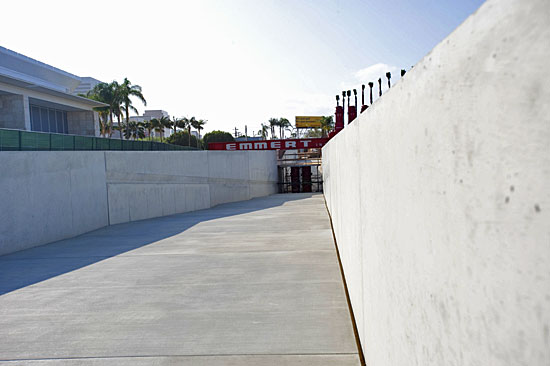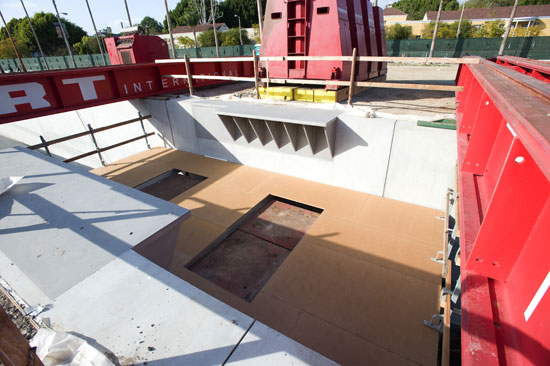
Visitors to “Levitated Mass” will walk down this channel, where the 340-ton boulder will be suspended overhead.
As it nears the end of its storied journey through the streets of four Southern California counties, The Rock is about to meet The Slot.
When artist Michael Heizer’s 340-ton boulder slowly rolls onto the grounds of the Los Angeles County Museum before dawn on Saturday, it will be parked alongside a meticulously constructed concrete trench that, away from the spotlight, has been put through its own complicated paces.
The Slot, as it’s officially known, is the 456-foot-long structure upon which The Rock will be permanently attached in the weeks ahead, a crucial element of the artist’s “Levitated Mass” installation. When completed, visitors will walk down this concrete trench with the boulder suspended 15-feet above. This, according to the artist, will create an illusion that the rock is floating, or levitating.
From the beginning, LACMA and its specialized team were under no illusion themselves that the task would be easy, given the unique engineering and safety issues involved with placing so much tonnage directly over the public noggin.
Months of strength testing, element analysis and 3D computer modeling were undertaken to satisfy everyone, including the City of Los Angeles, that The Rock would stay secure during an earthquake and true to Heizer’s vision.
“We don’t have more than one try. We can only get it right once,” says Ron Elad of the engineering firm Buro Happold, which was hired by LACMA to translate the artist’s design ambitions into achievable engineering principles. “Everything that is going to happen in attaching that rock was tested.”
David Lara, a spokesman for the Building and Safety Department, acknowledged some back-and-forth between the parties but added: “They provided what we needed and we provided what they needed.”
The entire slot structure was designed with the support of the rock’s weight in mind, including a 3-foot-thick concrete foundation and underground support of the walls adjacent to the rock’s mount. The aesthetics were further influenced by laws protecting disabled individuals. The channel’s length was calculated to create a slope gentle enough to allow for safe navigation by people in wheel chairs. Hand rails also were cut directly into the concrete walls.
The process for attaching the megalith, as LACMA likes to call it, will unfold out of public view, obscured by fences on the northwest corner of the museum’s campus, near Fairfax Avenue and Sixth Street. The trench itself is not even complete; construction was stopped 75-feet short to give the giant red transporter room to maneuver on Saturday, according to Meg Thomas of Aurora Development, the project’s manager.
If all goes well between now and then, here’s what Thomas says will happen next:
Within 10 working days, Emmert International’s specially-built transporter will be dismantled around the boulder, which will then be positioned by hydraulic lifts over the “rock chamber”—an area where two stainless steel plates jut across the top of the slot. With that accomplished, work will stop until the reclusive artist arrives from his Nevada home to determine the rock’s precise orientation between the plates.
The rock then will be permanently affixed through three methods. First, a high-density grout will be placed on the steel plates. Then, nine holes will be drilled through the plates and into the rock, about a foot deep. A high-strength epoxy will be injected into the holes, quickly followed by the insertion of pins, 1-inch in diameter. This technique is aimed at preventing the rock from lifting up or rolling over during an earthquake. Finally, six steel “wedges” will be placed around the rock to prevent side-to-side sliding. Since the wedges will be visible (unlike the pins), Heizer is designing wood models, which he’s expected to bring with him.
In all of this, Thomas says, the trick has been figuring out ways to attach the rock while complying with the artist’s intentions and the city’s instructions. “Half the art, in my opinion, is in its constructability,” she says.
That said, when it came to the aesthetic details of the slot, the artist has been exacting, as the man in charge of one of the slot’s defining characteristics—its precise concrete work—can tell you.
“He wanted razor-sharp corners” says Bill Hanson of Matt Construction, who was in charge of some 2,000 cubic yards of concrete. “It’s pretty difficult. You have to pay attention.” Heizer also wanted no visible joints or tell-tale signs of bolts under the concrete, also significantly raising the degree of difficulty.
Over the decades, Hanson, 65, says he’s worked on some pretty big “architectural concrete” projects, ranging from the Bonaventure Hotel in the mid-1970s to the Skirball Cultural Center in the mid-1990s. But “Levitated Mass,” it seems, may hold a special place of pride in a long career.
“I’m going to bring my seven grandkids to see it,” he says.
Posted 3/7/12







